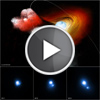CXC Home | Search | Help | Image Use Policy | Latest Images | Privacy | Accessibility | Glossary | Q&A
Tour of PSR B1259-63/LS 2883
Quicktime MPEG With closed-captions (at YouTube)
In astronomy, it is often difficult to figure out exactly far away objects are. For objects in our Solar System and nearby stars, astronomers can use reliable methods involving geometry. However, these techniques cannot be applied to objects beyond our immediate cosmic neighborhood. There are some rare circumstances where relatively simple geometric techniques can be used to determine distances to more far-flung objects.
This is the case of Circinus X-1, a system in which a neutron star is in orbit around a massive star. In 2013, astronomers watched as Circinus X-1 erupted in a giant burst of X-rays. Afterwards, they used NASA's Chandra X-ray Observatory and ESA's XMM-Newton to observe what happened next. The scientists now report that they see a set of four rings that appear as circles around Circinus X-1. What are these are these rings and what do they do? These rings are light echoes, similar to sound echoes that we may experience here on Earth. Instead of sound waves bouncing off a canyon wall, the echoes around Circinus X-1 are produced when a burst of X-rays from the star system ricochets off of clouds of dust between Circinus X-1 and Earth.
By combining the light echoes that Chandra detects with radio data from the Mopra telescope in Australia, which determined the distance to the intervening clouds, astronomers can estimate the distance to Circinus X-1 using relatively simple geometry. The light echo method generates a distance of 30,700 light years. The observation thus settles a large difference amongst previous results, one similar to this work and one indicating a much smaller distance of about 13,000 light years.
[Runtime: 02:06]
Quicktime MPEG With closed-captions (at YouTube)
In astronomy, it is often difficult to figure out exactly far away objects are. For objects in our Solar System and nearby stars, astronomers can use reliable methods involving geometry. However, these techniques cannot be applied to objects beyond our immediate cosmic neighborhood. There are some rare circumstances where relatively simple geometric techniques can be used to determine distances to more far-flung objects.
This is the case of Circinus X-1, a system in which a neutron star is in orbit around a massive star. In 2013, astronomers watched as Circinus X-1 erupted in a giant burst of X-rays. Afterwards, they used NASA's Chandra X-ray Observatory and ESA's XMM-Newton to observe what happened next. The scientists now report that they see a set of four rings that appear as circles around Circinus X-1. What are these are these rings and what do they do? These rings are light echoes, similar to sound echoes that we may experience here on Earth. Instead of sound waves bouncing off a canyon wall, the echoes around Circinus X-1 are produced when a burst of X-rays from the star system ricochets off of clouds of dust between Circinus X-1 and Earth.
By combining the light echoes that Chandra detects with radio data from the Mopra telescope in Australia, which determined the distance to the intervening clouds, astronomers can estimate the distance to Circinus X-1 using relatively simple geometry. The light echo method generates a distance of 30,700 light years. The observation thus settles a large difference amongst previous results, one similar to this work and one indicating a much smaller distance of about 13,000 light years.
[Runtime: 02:06]
(Credit: NASA/CXC/A. Hobart)
Return to PSR B1259-63/LS 2883 (July 22, 2015)



